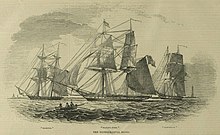
HMS Hydra was the lead ship of her class of wooden steam paddle sloops of the British Royal Navy, launched in 1838 at Chatham Dockyard. After taking part in operations during the Syrian War in 1840, she then served on anti-slavery operations and also as a survey vessel. She was scrapped in 1870.
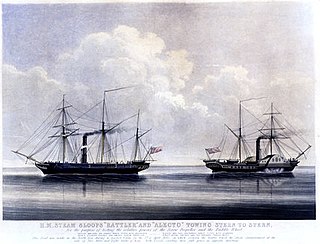
HMS Rattler was a 9-gun steam screw sloop of the Royal Navy, and one of the first British warships to be completed with screw propulsion. She was originally ordered as a paddle wheel 4-gun steam vessel from Sheerness Dockyard on 12 March 1841. She was reordered on 24 February 1842 as a propeller type 9-gun sloop from HM Royal Dockyard, Sheerness, as a new vessel. William Symonds had redesigned the ship as a screw propeller driven vessel.
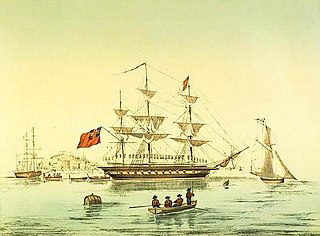
HMS Fly was an 18-gun sloop of the Royal Navy. She was responsible for the exploration and charting of much of Australia's north-east coast and nearby islands. She was converted to a coal hulk in 1855 and broken up in 1903.
HMS Trident was an iron paddle sloop built for the Royal Navy by Ditchburn & Mare in 1845 at Leamouth, London. She served in the Mediterranean, off West Africa and in the South Atlantic, and was broken up in 1866.

HMS Superb was a 80-gun second rate Vanguard-class ship of the line built for the Royal Navy in the 1840s. She was broken up in 1869.
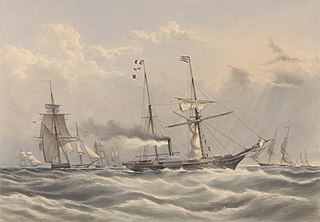
The Experimental Squadrons also known as Evolutionary Squadrons of the Royal Navy were groups of ships sent out in the 1830s and 1840s to test new techniques of ship design, armament, building and propulsion against old ones. They came about as a result of conflict between the "empirical" school of shipbuilding, the "scientific" school led by the first School of Naval Architecture, and the "traditional" school led by master shipwrights from the royal dockyards.
The Impérieuse was a 40-gun Minerve-class frigate of the French Navy. The Royal Navy captured her in 1793 and she served first as HMS Imperieuse and then from 1803 as HMS Unite. She became a hospital hulk in 1836 and was broken up in 1858.
HMS Hazard was an 18-gun Favorite-class sloop of the Royal Navy. She was one of four Favorite-class ship sloops, which were a ship-rigged and lengthened version of the 1796 Cruizer-class brig-sloop. All four ships of the class were ordered on 10 June 1823. She was launched in 1837 from Portsmouth Dockyard.

HMS Niger was originally slated to be built as a Sampson designed sloop; however, she was ordered as a First-Class sloop with screw propulsion on 20 February 1845 to be built at Woolwich Dockyard, along the design developed by Oliver Lang and with a hull like the Basilisk designed paddle sloops. Her armament and engine were to be like the Encounter Design building at Pembroke. A second vessel (Florentia) was ordered on 26 March 1846 but after her keel was laid at Pembroke Dockyard, her construction was suspended on 6 October 1846 then cancelled three years later, on 22 May 1849. Niger She conducted important propulsion trials, finally proving the superiority of screw propulsion and served in West Africa, the Crimea, China, the East Indies and Australia. She took part in the New Zealand wars in 1860 and was sold for breaking in 1869.
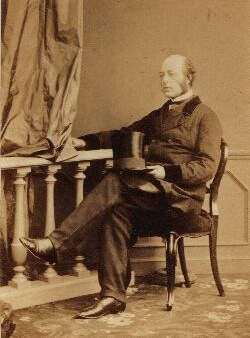
Admiral Sir Arthur Cumming was an officer of the Royal Navy.

HMS Phoenix was a 6-gun steam paddle vessel of the Royal Navy, built in a dry dock at Chatham in 1832. She was reclassified as a second-class paddle sloop before being rebuilt as a 10-gun screw sloop in 1844–45. She was fitted as an Arctic storeship in 1851 and sold for breaking in 1864.

HMS Lizard was a Jackal-class second-class iron paddle gunvessel of the Royal Navy. She was built by Robert Napier and Sons at Govan to a design by William Symonds, the Surveyor of the Navy. She was launched in 1844, was damaged at the Anglo-French blockade of the Río de la Plata, performed fishery protection duties off Scotland and broken up in 1869.

HMS Jackal was a Jackal-class second-class iron paddle gunvessel of the Royal Navy.

HMS Encounter was ordered as a First-Class Sloop with screw propulsion on 5 February 1845 to be built at Pembroke, in accordance with the design developed by John Fincham, Master Shipwright at Portsmouth. Her armament was to consist of 8 guns. She was to have a more powerful steam engine rated at 360 nominal horsepower. In 1848 she would be altered abaft and lengthened at Deptford prior to completion. A second vessel (Harrier) was ordered on 26 March 1846 but after her keel was laid at Pembroke Dockyard, her construction was suspended on 9 September 1846 then cancelled five years later, on 4 April 1851. Encounter had her armament radically altered in 1850 and she was broken up at Devonport in 1866.

HMS Reynard was part of the 1847 Program, she was ordered on 25 April as a steam schooner from Deptford Dockyard with the name ‘Plumper’. However, the reference Ships of the Royal Navy, by J.J. College, © 2020, there is no entry that associates the name Plumper to this build. The vessel was reordered on 12 August as an 8-gun sloop as designed by John Edye. She was launched in 1848, conducted anti-piracy work in Chinese waters and was wrecked near Pratas Island in the South China Sea on 31 May 1851.

HMS Desperate was originally slated to be built to the Sampson designed steam vessel rated as a Steam Vessel First Class (SV1); however, the Admiralty, first rerated the vessels as First Class Sloops on 19 April 1845 then on the 9 May 1845, she was ordered as First-Class screw sloops to be built from a design of Sir William Symonds, Surveyor of the Navy. She would be a 10-gun vessel with 400 NHP engines. She served in the Baltic during the Crimean war, and as a store ship to Edward Augustus Inglefield's Arctic expedition. She was broken up by 1865.
HMS Archer was initially ordered as one of two Rifleman type gunvessels on 25 April 1846. With her construction suspended in September 1846, she was reordered on as a sloop on 25 April 1847 to be constructed to a design of John Edye as approved on 25 August. With the exception of two years on Baltic service during the Russian War of 1854 to 1855 she spent the majority on the West Coast of Africa on the anti-slavery patrol. This service involved anti-slavery work on the coasts of the Bight of Benin, and was notoriously unhealthy, with tropical diseases taking a heavy toll of British seamen. One of her commanders died and three others were invalided. Archer was reclassified as a corvette in 1862. She finally returned to Home waters, being sold for breaking in January 1866
HMS Inflexible was a Bulldog-class sloop designed by Sir William Symonds, Surveyor of the Navy. Originally she was ordered as a Driver-class sloop, however, under Admiralty Order of 26 December 1843 she was directed to be built to a new specification. After commissioning she sailed for the East Indies and participated in the last year of the New Zealand War of 1845 to 1847. She then was in the Black Sea for the Russian War followed by the Second Opium War with China. She was sold for breaking in July 1864.
HMS Scourge was a Bulldog-class sloop designed by Sir William Symonds, Surveyor of the Navy. Originally she was ordered as a Driver-class sloop, however, under Admiralty Order of 26 December 1843 she was directed to be built to a new specification. She was initially commissioned for service with the Channel Squadron before moving to the North America and West Indies Station. She then served in the Mediterranean then the west coast of Africa. Her final service was in the Mediterranean. She was broken in 1865.

HMS Bulldog was a Bulldog-class sloop designed by Sir William Symonds, Surveyor of the Navy. Originally she was ordered as a Driver-class sloop, however, under Admiralty Order of 26 December 1843 she was directed to be built to a new specification. After commissioning she sailed for the Cape of Good Hope. She then was in the Baltic Sea for the Russian War. She carried out ocean sounding for the Atlantic telegraph. She was lost while in action with the Haitians in 1865.

